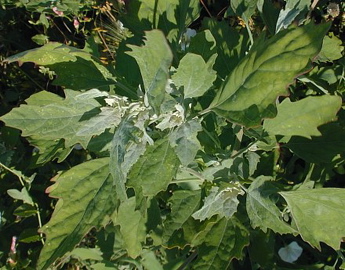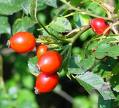Wildcrafting as Nature Study
Wildcrafting is learning how to identify and eat edible wilds.
It's a way to help students connect with the rest of Nature, and develop their observation skills, critical thinking and natural intelligence, all while developing survival skills — which could become important should our fossil-fuelled agricultural system break down.

Lambsquarters
Wildcrafting has been called
- the art of hunting and harvesting herbs in the wild (Charles Garcia)
- the age-old practice of collecting plant materials in their natural habitat for food, medicine, and craft (Ila Hatter)
- getting your hands dirty as you develop life-long relationships with plants (Chestnut School of Herbal Medicine)
- gathering plant material from its native "wild" environment for food, medicine, fiber, or art (Howie Brounstein).

Learning about the plants in person, where they grow, engages the senses as we smell, touch, see, and often taste our green allies. This intimate and holistic approach helps us to integrate all we learn about plants as food and medicine. Blending spirituality and the study of life, we honor the traditions of our elders as well as useful knowledge gained through scientific exploration. Reverence for the sacredness of all life is part of our guiding philosophy and inspiration.
— Chestnut School of Herbal Medicine
Wildcrafters learn about growing conditions, weather patterns, life cycles, ecological ranges, and plant folklore. They develop an environmental ethic (the first "rule" of collecting in the wild is to never threaten the survival of the stand of plants). They discover how First Peoples lived off the land where they, themselves, now live. They get excited about all the possible edible wilds, even just amongst plants growing on the fringes of the backyard or school grounds, or in vacant city lots:

- nettles for fibre and soup
- several kinds of nuts
- natural dyes
- wild mushrooms (careful with this one!)
- mint, chamomile and other herbs for tea
- wild fruit such as rosehips, blackberries and crabapples for jams and compotes
- dandelion, lambsquarters and other greens for salads
- vines and branches for basketweaving and other crafts
- herbal medicines (again, be careful with this when working with schoolchildren)
Please watch this delightful — and instructive —
video
about a group of secondary school students in British Columbia, Canada, learning how to forage for their own food as part of a summer program called Sustainability Toolbox.

Responsible wildcrafting connects children to nature in a direct way, helps explain the sources of food, and teaches them the basics of sustainability.
— Richard Louv, Last Child in the Woods
Eco-herbalist Kahlee Keane offers the following Wildcrafter’s Ethic:
- Before taking plants from the wild, attempt to cultivate them first. Discover how to grow native and medicinal herbs and share your knowledge, seeds, and cuttings with others. Put to good use previously tilled soil instead of destroying the few remaining wild places.
- When harvesting in the wild, treat the native plant complexes like the fine perennial gardens they are. Propagate while you collect by replanting root crowns, scattering seeds, coppicing or pruning shrubs and trees to enhance growth. Always monitor harvest areas each year to check your successes. In short, keep a caretaker point of view.
- Whenever possible, determine the quantity of individual plants in each colony required for that colony to remain viable before harvesting. Do not let your predetermined needs influence your collecting.
- At most only 25 percent of weedy plants should be gathered in a harvest area; no more than five percent of the native plants.
- Do not harvest endangered, threatened or sensitive plants unless absolutely necessary (such as hunger). Become familiar with the plants by seeking information from the head botanist at your local university.
- When appropriate, only harvest a part of each plant by pinching off individual leaves, flower heads, or rhizome segments, leaving the remainder intact to regenerate.
- Species are products of thousands, even millions, of years of evolution. Extinction is the ultimate catastrophe for any species. Once lost, it cannot be regenerated.
Howie Brounstein offers a
Wildcrafting Checklist
that lists excellent questions for wildcrafters (and teachers of wildcrafting students) to pose. He points out that "wildcrafting is stewardship," and asks students to find their own meaning for this phrase. "To me," he says, "it means if you take care of the earth, the earth will take care of you. I am a caretaker of these wild plants, returning year after year to many places to watch and protect the plants that support me."
Teachers new to wildcrafting will probably be able to find a local resource person (for example, an Aboriginal elder or an herbal medicine specialist) through word-of-mouth or internet research. Otherwise, do some careful research with your students using well-respected field guides.

The woods and fields are a table always spread.... Originally, wildcrafting was the only grocery store, medicine chest and hardware store available to man [sic].... In wildcrafting we are harvesting the bounty of the earth and should always approach collecting with respect and thankfulness.
— Ila Hatter, wildcrafting.com
Return to Transformative Nature Study
Go to GreenHeart Education Homepage



